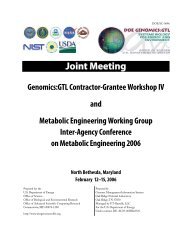Joint Meeting - Genomics - U.S. Department of Energy
Joint Meeting - Genomics - U.S. Department of Energy
Joint Meeting - Genomics - U.S. Department of Energy
Create successful ePaper yourself
Turn your PDF publications into a flip-book with our unique Google optimized e-Paper software.
12<br />
Systems Biology for DOE <strong>Energy</strong> and Environmental Missions<br />
are certain filamentous fungi. One reason that vascular<br />
plant cell walls are so difficult to digest is that their lignin<br />
prevents even the smallest enzymes from penetrating.<br />
Filamentous fungi solve this problem by making lignocellulose<br />
more hydrophilic and porous, with the result<br />
that hydrolytic enzymes can eventually penetrate the<br />
substrate.<br />
To make lignocellulosics permeable to enzymes, filamentous<br />
fungi use a variety <strong>of</strong> small, diffusible reactive oxygen<br />
species (ROS) such as hydroxyl radicals, peroxyl radicals,<br />
and possibly phenoxy radicals. These radicals diffuse into<br />
the cell walls and initiate biodegradative radical reactions.<br />
When lignin is the target, radical attack results in various<br />
extents <strong>of</strong> oxidation and depolymerization.<br />
These small diffusible oxidative species are important<br />
tools used by filamentous fungi to make the cell wall<br />
accessible to enzymes. Despite this, we have a poor<br />
knowledge <strong>of</strong> how these oxidants are spatially distributed<br />
in biodegrading lignocellulose relative to the fungal<br />
hypha that produce them. The goal <strong>of</strong> this project is to<br />
remedy this deficit through fluorescence microscopy <strong>of</strong><br />
newly designed sensors that will serve as in situ reporters<br />
<strong>of</strong> biodegradative radical production. While developing<br />
these sensors, we will test the specificity <strong>of</strong> reaction <strong>of</strong> a<br />
variety <strong>of</strong> promising fluorophores to increase the arsenal<br />
<strong>of</strong> ROS specific probes available for work at low pH.<br />
We will also demonstrate how binding these fluorescent<br />
probes to beads improves fluorescent imaging by preventing<br />
dye diffusion, limiting interferences, and allowing the<br />
use <strong>of</strong> almost all dyes (lipo- or hydrophilic, cell permeant<br />
or not) to be used in extracellular environments. Finally,<br />
we will use these sensors to produce oxidative maps that<br />
will help us to understand how fungi generate ROS and<br />
how they use these ROS to make cell walls more accessible<br />
to enzymes.<br />
Method<br />
We are attaching fluorescent dyes to silica beads. Our<br />
first bead has BODIPY 581/591® on a 3µm porous<br />
HPLC bead. This dye’s emission changes irreversibly<br />
from red to green upon oxidation by ROS. The ratio <strong>of</strong><br />
red to green emission provides a quantitative measure<br />
<strong>of</strong> the cumulative oxidation at that point in space. Dyes<br />
with reactivity to specific ROS, pH, or other metabolites<br />
<strong>of</strong> interest are envisioned.<br />
* Presenting author<br />
Figure. Fluorescent dye attached to silica bead<br />
There are many advantages gained by fixing the dye to<br />
bead. We design the bead to emit two fluorescent signals,<br />
so that the ratio <strong>of</strong> the two signal intensities provides<br />
quantitative information. Immobilized dyes are prevented<br />
from moving after reaction, so partitioning is impossible,<br />
they cannot be ingested, and the fluorescence from the<br />
dye is clearly distinguishable from background.<br />
Beads are placed on wood samples and imaged with a<br />
confocal microscope during fungal colonization. Images<br />
can be analyzed to provide the analyte concentration<br />
maps as well as an overlay <strong>of</strong> the location <strong>of</strong> fungal<br />
hypha.<br />
12<br />
Dynamic Molecular Imaging <strong>of</strong><br />
Lignocellulose Processing in Single<br />
Cells<br />
Amy Hiddessen, Alex Malkin, and Michael Thelen*<br />
(mthelen@llnl.gov)<br />
GTL<br />
Chemistry Directorate, Lawrence Livermore National<br />
Laboratory, Livermore, California<br />
Of central importance to our nation’s energy resources<br />
is the pursuit <strong>of</strong> alternative fuels directly from plant<br />
material rich in lignin and cellulose. The abundant and<br />
intractable nature <strong>of</strong> these biopolymers limits their practical<br />
use to produce bi<strong>of</strong>uel precursors, and so presents<br />
an extraordinary scientific challenge. A comprehensive<br />
understanding <strong>of</strong> the natural or engineered breakdown<br />
<strong>of</strong> plant cell wall materials must be addressed on several<br />
levels, including the examination <strong>of</strong> detailed ultrastructural<br />
changes that occur in real time. To accelerate<br />
research on the cellular and molecular details <strong>of</strong> the cell<br />
wall deconstruction process, we are developing sophisticated<br />
analytical tools specifically to visualize changes<br />
in surfaces, polysaccharides and proteins. Molecular<br />
surface characterization can be directly linked with high





